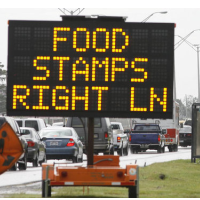For the First Time, Working-Age Americans are Majority of Food Stamp Recipients
 (AP Photo)
(AP Photo)
Food stamps are no longer a form of government assistance that mostly children and seniors need to survive. Today, the majority of recipients in the United States are working-age people, including those employed in low-wage jobs.
This change in the food stamp population began during the Great Recession and has continued during the weak economic recovery. Over the past five years, more than 50% of U.S. households receiving food stamps have been adults age 18 to 59, according to the U.S. Census Bureau's Current Population Survey.
The Associated Press (AP) reports that multiple factors have caused more working-age adults to utilize food stamps (officially known as the Supplemental Nutrition Assistance Program, or SNAP). These factors include persistent high unemployment, stagnant wages and dwindling middle-income jobs.
“A low-wage job supplemented with food stamps is becoming more common for the working poor,” Timothy Smeeding, an economics professor at the University of Wisconsin-Madison who specializes in income inequality, told the AP.
“Many of the U.S. jobs now being created are low- or minimum-wage—part-time or in areas such as retail or fast food—which means food stamp use will stay high for some time, even after unemployment improves,” he added.
Many Americans, however, will likely be affected by the $11 billion in cuts to SNAP benefits that Congress voted for in 2010, which are just now beginning to take effect. Last month the program lost $5 billion in funding, and two more cuts are scheduled to hit by September.
Among other important findings about SNAP users, according to data analysis for the AP conducted by economist James Ziliak at the University of Kentucky Center for Poverty Research:
- 28% of food stamp households are headed by a person with at least some college training, up from 8% in 1980
- The percentage of those with four-year college degrees has increased from 3% to 7%
- High-school graduates relying on SNAP have gone up to 37% from 28%.
- Food stamp households headed by a high-school dropout have dropped by more than half, to 28%.
- Today, one in seven Americans is covered by SNAP.
-Noel Brinkerhoff
To Learn More:
The New Face of Food Stamps: Working-Age Americans (by Hope Yen, Associated Press)
Food Stamp Cuts Leave African-Americans Vulnerable (by Candace Y.A. Montague, The Grio)
39% of New York Bank Tellers Need Public Assistance (by Matt Bewig, AllGov)
USDA Refuses to Release Food Stamp Profits Details (by Noel Brinkerhoff, AllGov)
Which Corporations Profit from Food Stamps? (by Noel Brinkerhoff and Vicki Baker, AllGov)
- Top Stories
- Unusual News
- Where is the Money Going?
- Controversies
- U.S. and the World
- Appointments and Resignations
- Latest News
- Trump Offers to Return Alaska to Russia
- Musk and Trump Fire Members of Congress
- Trump Calls for Violent Street Demonstrations Against Himself
- Trump Changes Name of Republican Party
- The 2024 Election By the Numbers






Comments